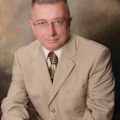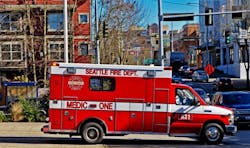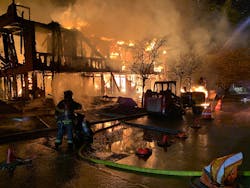Seattle Fire Department: Early on the Front Lines of COVID-19
Editor's note: Find Firehouse.com's complete coverage of the COVID-19 pandemic here.
In an effort to provide our readers with the most up-to-date information possible on the impact of COVID-19 on the fire and emergency medical services, Firehouse connected with Fire Chief Harold Scoggins and Deputy Chief Ronald R. Mondragon regarding the experiences of the Seattle Fire Department.
Scoggins has more than 30 years of experience in the fire service. He started his firefighting career as a member of the U.S. Air Force where he served as a firefighter and, in 1989, he joined the Glendale, CA, Fire Department where he advanced through the ranks to fire chief. He has served as the fire chief of the Seattle Fire Department since 2015. Scoggins has partnered with the city’s Office of Emergency Management to help lead the city’s response to the COVID-19 outbreak.
Mondragon has more than 40 years of experience in the fire service. He began his career in 1978 with the Kenmore, WA, Fire Department, then joined the Seattle Fire Department in 1980 where he worked his way through the ranks to his current assignment as deputy chief. In his current role as Deputy 1B, he oversees all daily B-Platoon Operations, responding and taking command at all major incidents requiring an expanded command structure. He previously served as Deputy 2 Chief, overseeing citywide special operations, special events and area command.
Seattle provides fire, inspection, and emergency medical response to a population of about 800,000 from 33 stations citywide. Situated near the Life Care Center of Kirkland, WA, which is the nursing home often referred to as ground zero in the United States for the coronavirus pandemic, combined with their position as a center of transportation and commerce, along with a large homeless population, presents them with a wide range of challenges. Here are their experiences.
Firehouse: What are the greatest challenges you’ve faced so far?
Scoggins: In the last six weeks we’ve had many. The biggest is trying to plan for the unknown. Really understanding the virus and disease has been a challenge to keeping our responders safe.
Mondragon: Learning about the impact of COVID-19 to the community and to our firefighters. Assuring that our firefighters are safe and not spreading the disease to our patients and each other and trying to assure adequate staffing levels.
Another concern is that we’ve been forced to curtail inspections as well as training. Our focus has been on COVID-19 response, awareness, and sterilization of apparatus, tools, and personnel. All the while we continue to get heart attacks, car fires, and structure fires on a daily basis. There’s also the question of how we will deal with our building inspections down the road? We’ve not only got our regular businesses to consider, but things like high-hazard residences, industry, master harbor permits, and large quantities of chemicals transported by sea, land, and air.
Firehouse: We see many concerns about PPE supplies for first responders. What is your status?
Scoggins: Seattle Fire Department is doing well. We have a pandemic plan that we are operating under. The plan calls for us to have a cache of supplies for situations like this. Based upon estimated run numbers we should have 8 to 12 weeks on hand. We’re currently in the resupply process, and will be doing OK with the anticipated deliveries coming in. I’m proud of our team who are keeping up to date and up to speed. Planning makes a difference.Mondragon: We are fortunate that former Assistant Chief A.D. Vickery was very conscientious regarding challenges such as epidemics, and stockpiled equipment and wrote plans. All fire personnel who have close contact with a patient are wearing full PPE, which includes a mask, eyewear, gown, and gloves. PPE is removed at the scene and placed in a biohazard waste bag, and disinfection steps are taken before crew members get in the apparatus or return to the station. This effort helps prevent possible spread of the virus from the incident location to the station. Our exposures started at high-risk facilities, where PPE is needed on all responses—even automatic alarms. We also have a significant vulnerable population in the homeless where the city is enforcing social distancing at their shelters.
Firehouse: Field hospitals are also a frequent tool in response. Are you using them in Seattle?
Scoggins: Governor Inslee announced April 8 that our hospitals have capacity to deal with this crisis, and the field hospital will be returned to FEMA for redeployment. As a veteran, I was proud to see Brigadier General Doug Cherry and the military come into our community and stand with us. Mondragon: The field hospital was envisioned as a support facility for emergency rooms in order to keep critical care beds available. The fire department was not directly transporting.Firehouse: How are you handling decontamination and quarantine?
Scoggins: We are doing OK on all fronts. We spent time ensuring that personnel had a plan and a process. Fire stations have been provided a checklist for cleaning apparatus and all spaces at the fire stations, along with a supply of disinfectant and sanitizer. A message is relayed twice daily over the building public address system at 7:15 a.m. and 8:15 p.m. instructing members to conduct disinfection procedures. The timing of this message is intentional, as it occurs before the oncoming shift arrives at work at 8 a.m. and approximately 12 hours after the start of the shift.We have also developed a process to provide enhanced disinfection of facilities and apparatus. As soon as we become aware of a member who has tested positive for COVID-19, and has spent time at a fire station, we initiate this enhanced disinfection process. This added measure is delivered by the department's Hazardous Materials Team. The department is fortunate to have this in-house resource for disinfection, that we are able to utilize under these circumstances.
We continue to isolate or quarantine as appropriate when we have members come into contact with COVID-19 positive or symptomatic patients. We’ve also been given approval by the Washington State Department of Health to do our own Coronavirus testing under medical direction. Since we started three weeks ago, we have shared this service with other first responders, both within the city and the region.
Mondragon: If anyone becomes symptomatic while on shift, they are sent for testing, and those who came in contact must be identified. The city has secured one hotel where personnel can isolate or quarantine and two hotels to serve as health care facilities where public safety personnel can be quarantined, or where they may voluntarily stay if they have an at-risk or COVID-19 positive person at home. As a result of careful planning, we have closed our stations to members of the public and are limiting non-essential contact among crews from other stations.Firehouse: Over the next two to four weeks, what should others plan for?
Scoggins: Make sure that your people are OK. This pandemic can still overwhelm us. There will be issues of tiredness and morale, but we need to maintain a certain pace. Keep seeking, learning and don’t be in limbo. Reach out to your peers to find out what they are doing. Don’t get complacent.Mondragon: Even though health professionals have stated the curve seems to be flattening, we’re concentrating on how to function with minimal staffing, knowing that we need to plan for the worst. Right now, we are committing fewer firefighters to the “hot zone” which is limiting our exposure and helping to conserve our PPE supply. We also have additional plans in place for staffing should we shift to the next level in our pandemic plan.Firehouse: What can other communities learn from the Seattle experience?
Scoggins: If I had to look back and do anything over, we would have immediately changed our dispatch protocols to the most conservative possible. As it was, it took us about three steps to get there. Now we’re treating all calls as if the patient is COVID-19 positive, and two firefighters make first contact wearing PPE. If it turns out they are suspected for COVID-19, then everyone else suits up. If not, then the rest of the crew can enter. This also helps manage our inventory. We designated a COVID-19 planning group early on and activated our department’s Resource Management Center to look at exposure concerns and begin to put procedures in place for our members.Mondragon: Three things: 1. Put pandemic plans in place. Viruses have been around for a long time. This one is particularly contagious and rapidly moving. Consider worst case scenarios when it comes to staffing, and don’t forget that you are responsible for supporting your mission every day. 2. Maintain a basic cache of PPE. A 3-week supply gets you started and buys time to secure more. 3. Develop relationships with all essential services. This is not a fire department only event. Everyone needs to be at the table.Firehouse: Are there any other thoughts you’d like to share?
Scoggins: I’d really just like to say thank you to all the men and women of the Seattle Fire Department for their performance. Our first involvement began on January 22, and we have been moving at a rapid pace since then. Our men and women have been working hard on so many fronts. And thank you to all who served not just here, but everywhere around the country.Mondragon: We have a number of very critical specialized teams such as hazmat, technical rescue, tunnel, confined space, etc. Any of these could be easily impacted for staffing, resulting in their closure, or being scaled back. You don’t just have to worry about your fire station, but about all the resources in your department.
In the early stages of the event, we were reactive. It’s still changing day to day, but increasingly thought is being given to the new normal. What will it look like and how will we get there?
Firehouse wishes to express thanks to Chief Scoggins and Deputy Chief Mondragon for taking time from their schedules during this crisis, and to Kristin Tinsley, senior communications manager/PIO for the Seattle Fire Department for her assistance.About the Author

Barry Furey
BARRY FUREY, who is a Firehouse Contributing Editor, provides consulting and training services in emergency communications. He is the former director of the Raleigh-Wake Emergency Communications Center in North Carolina. During his 50-year public safety career, he has managed 9-1-1 centers and served as a volunteer fire officer in three other states. In 2005, Furey received a life membership in the Association of Public-Safety Communications Officials (APCO) International for his continued work in emergency communications. Furey was inducted into the Firehouse Hall of Fame in 2017.



